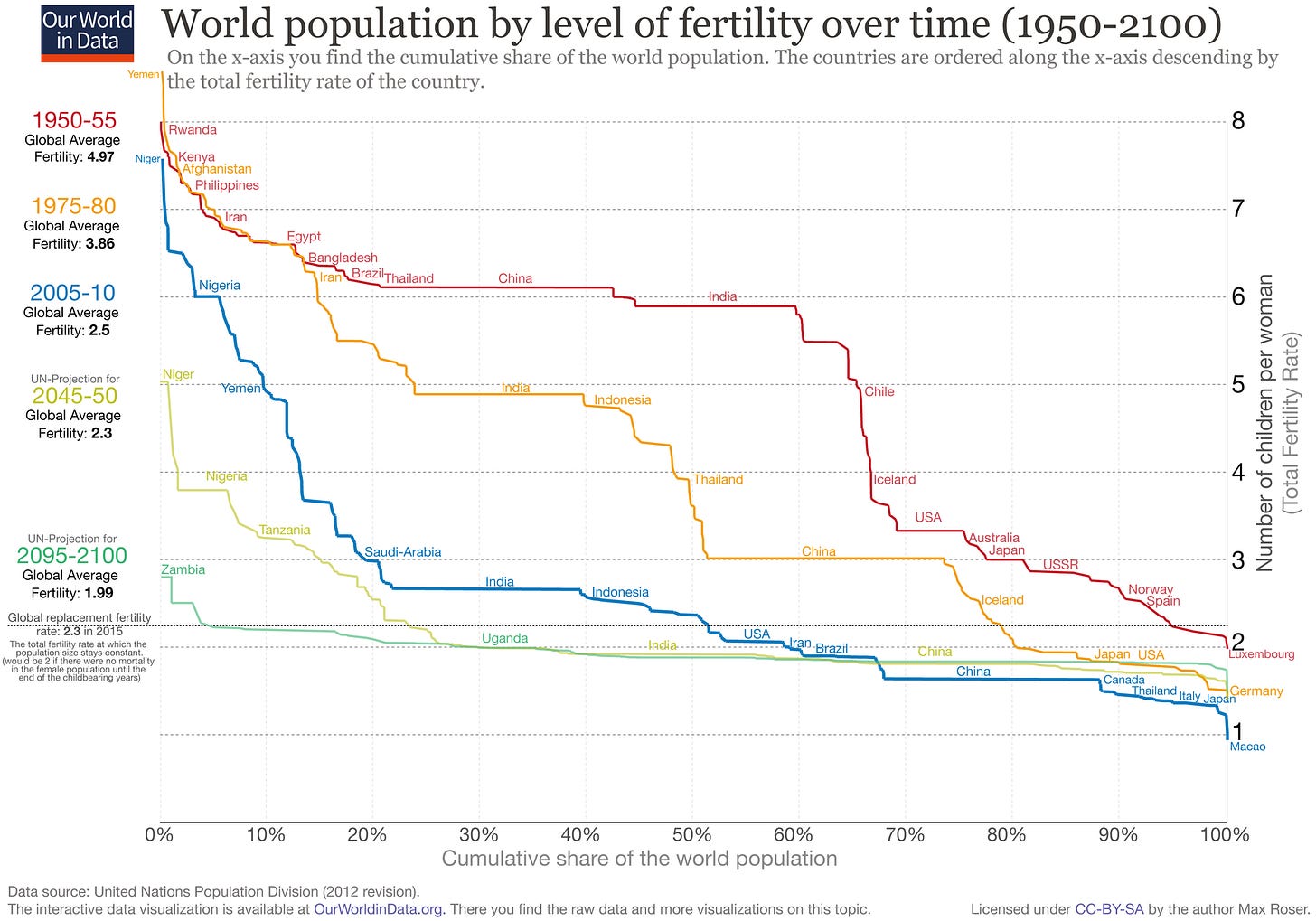📊 5 charts: Declining fertility rates, COVID vaccines, insulin consumption, market outliers
5 telling charts on the state of health and biotech
Hi friends 👋
Welcome to Health & Wealth — your weekly source of the latest health research and biotech trends. I focus on writing deep dives on biotech companies and health optimization strategies. But today I’m highlighting 5 charts that each say a lot about the state of health and biotech.
5 charts for you today:
COVID vaccines. The pandemic isn't over, but it's worth celebrating the lives that have been saved.
Declining fertility rates. A sign of women empowerment but also concerning as the population ages.
Insulin consumption. The US leads in global consumption of insulin.
Select outliers. A small number of outliers drives the majority of excess stock returns.
Biotech is small. Relative to the rest of the market, life sciences is still small.
How many deaths and hospitalizations did COVID vaccines prevent?
Researchers modeled a world with and without vaccines in 2021. The Commonwealth Fund estimates Covid-19 vaccines prevented about 1.1 million deaths and 10.3 million hospitalizations in the United States.
While loss and destruction tell one story, this chart presents the other side of the story. Vaccination radically altered the trajectory of the pandemic.
Declining fertility rates
Over the last 50 years, the global fertility rate has halved. Today 80% of the world population lives in countries with a fertility rate below 3 children per woman.
Future projections estimate that trend will only continue.
I have two minds about this — on the one hand, family planning is a sign of female empowerment. Women have increased access to contraception, education, and career opportunities. There's a significant opportunity cost to having more children, especially in developed countries. As a young woman, I don't plan on having more than two kids.
On the other hand, as birth rates decrease, the population's age profile becomes skewed towards an aged population (living longer). This puts an undue burden onto fewer young adults to continue building and growing our economy.
What can we do about this?
I think it's over-simplistic (and arrogant) to conclude from this chart that educated women should “just have more kids.” But we should actively build towards a future where the financial and cultural incentives are aligned for people to have kids — rather than writing it off because the opportunity cost of bringing up children today is too high.
There's no way to parse this — we're in a dire metabolic crisis, especially in the United States.
1 in 3 American adults have prediabetes. Of those with prediabetes, more than 84% don't even know they have it. The United States makes up over 80% of global insulin sales and a 30% share of total insulin volume.
If we only focus on medication management for diabetes, this trend will only continue.
I previously wrote about normalizing continuous glucose monitoring (CGM) to help people learn how to make actionable dietary and lifestyle changes to bring Type 2 diabetes numbers down.
Select outliers drive excess returns

The truth is the majority of excess returns are the result of a small number of stellar companies that grow into giants. Indices only make a small fraction of these outlier returns.
In biotech, this is especially true — companies either make or break. Only a select few succeed in a graveyard of companies with abysmal performance.
Looking at a basket of 81 biotech companies with a market cap range of $100-$200M and their performance from 2016 to 2022 — the average return among the remaining listed companies was 4.7%. The top 8 companies won (>200% return), but companies other than the upper quartile have returned -81%.
As such, finding the big winners early can lead to greater returns than a basket approach, especially with biotech investing. Food for thought as we navigate through rough waters this year.
Biotech: the featherweight champion of the markets
This chart is from Bruce Booth's blog Life Sci VC. Appreciating the relative scale of life sciences helps you understand why biotech is so sensitive to small changes in macro sector allocations. Some excerpts from Bruce's piece:
“Biotech punches way above its weight-class, and that's never been more apparent than in this pandemic and the race for a COVID vaccine.
Here's a stat that sums up the relative scale of biopharma: The top 3 Tech companies have a greater combined market capitalization than all of the biotech and pharma universe combined (>$3.5T), including near ~1K publicly-traded companies.
Just three companies, Microsoft, Apple, and Amazon – are collectively bigger in market cap than the combined valuations of J&J, Pfizer and all of the other biopharma companies down to the most recent IPO and micro-cap stock. And there are dozens of other huge tech players, from Alphabet to Facebook to Intel and others, behind these three. Our sector is simply dwarfed by their size.
The reality is very small aggregate changes in how investors allocate the nearly $50 Trillion in equity value in the US markets can have big impacts on biotech. As an example, if asset managers moved just 0.1% towards the life sciences, that would be $50B in value – more than all of the new public equity issuances in biopharma in 2020, a boom year for offerings.”
Laugh of the week
Not a subscriber? Sign up for free
For more content about biotech investing and health optimization, feel free to follow me @healthwealthgen
Thanks for reading!
Christina








love your work Christina!